The Mastic Gum Market is estimated to be valued at USD 751.6 million in 2025 and is projected to reach USD 1080.8 million by 2035, registering a compound annual growth rate (CAGR) of 3.7% over the forecast period.
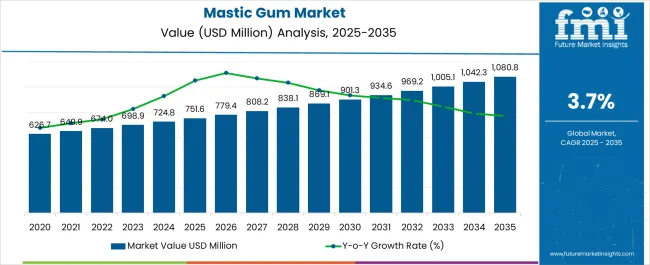
| Value | |
|---|---|
| Mastic Gum Market Estimated Value in (2025 E) | USD 751.6 million |
| Mastic Gum Market Forecast Value in (2035 F) | USD 1080.8 million |
| Forecast CAGR (2025 to 2035) | 3.7% |
The mastic gum market is experiencing strong growth due to rising consumer awareness of natural health products, expanding applications in food and beverages, and increasing demand within nutraceuticals. Its functional benefits, including digestive health support and antimicrobial properties, are contributing to greater adoption across global markets.
Regulatory encouragement for plant based and clean label ingredients is further supporting its integration into product formulations. Advances in extraction and processing methods are enhancing product purity and scalability, improving commercial viability.
Growing interest from the food service industry and premium personal care brands is also broadening its market footprint. The outlook remains positive as consumer preference for natural, sustainable, and multifunctional ingredients continues to align with the unique benefits of mastic gum.
The market is segmented by Type and End-user Industry and region. By Type, the market is divided into Chewed Pure Mastic Gum, Xylitol Mastic Gum, and Others. In terms of End-user Industry, the market is classified into Food Service Industry, Pharmaceutical & Medicinal Industry, and Others. Regionally, the market is classified into North America, Latin America, Western Europe, Eastern Europe, Balkan & Baltic Countries, Russia & Belarus, Central Asia, East Asia, South Asia & Pacific, and the Middle East & Africa.
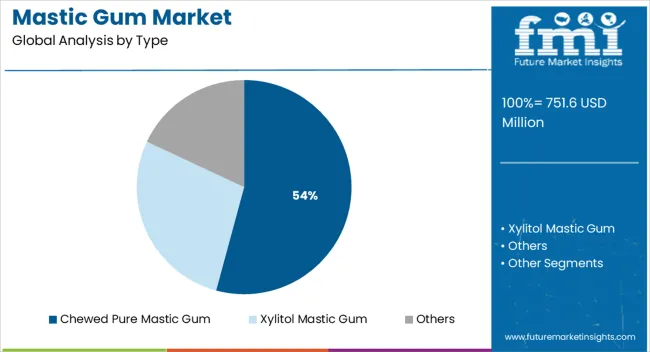
The chewed pure mastic gum type segment is projected to account for 54.20% of market revenue by 2025, making it the dominant type. Growth in this segment is supported by its increasing recognition as a natural alternative for oral care, digestive wellness, and traditional medicine practices.
The demand for authentic and minimally processed products has positioned chewed pure mastic gum as a preferred option among health conscious consumers. Its use in promoting oral hygiene and digestive balance has further solidified adoption in both developed and emerging markets.
Rising consumer inclination toward natural chewing products without synthetic additives has also strengthened its leadership in the type category.
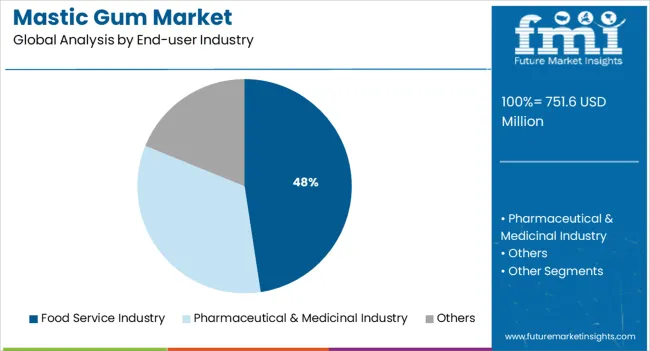
The food service industry segment is expected to hold 47.60% of total revenue by 2025, positioning it as the leading end user category. This is driven by the growing incorporation of mastic gum in culinary preparations, confectionery, and specialty beverages, where its unique flavor and health properties enhance value.
Restaurants and cafes have been increasingly utilizing mastic gum as a differentiating ingredient in premium offerings. Furthermore, demand has been reinforced by consumer interest in authentic and regional flavors, especially within Mediterranean and Middle Eastern cuisines.
The segment’s prominence is supported by rising partnerships between ingredient suppliers and food service providers, ensuring greater accessibility and innovative applications of mastic gum in mainstream dining experiences.
With a CAGR of 3.8% between 2020 and 2025, the global market for Mastic Gum Market expanded from USD 580.0 Million to USD 673.3 Million.
The growing demand for mastic gums in the food service, pharmaceutical, and medical industries is a key driver driving the expansion of the global mastic gums market. The market is anticipated to be driven over the projected period by rising consumer awareness of the use of mastic gums to improve health conditions including dry mouth.
Additionally, the expanding demand for mastic gum products in the food service business, pharmaceutical industry, and medical sector is being fueled by rising per capita income, changing consumer lifestyles, and increased consumer awareness of the resins from mastic trees.
With a high CAGR of 3.7% over the projected period, it is expected that the global Mastic Gum Market would increase from USD 751.6 Million in 2025 to USD 1,005.1 Million by 2035.
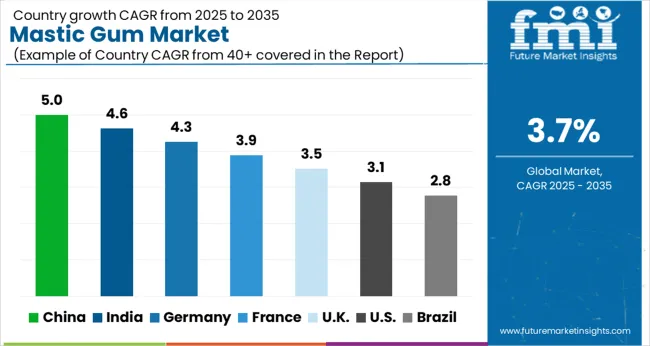
The Mastic Gum market in North America is expanding rapidly. With new and innovative uses for the product, including food additives and skincare products, more manufacturers are looking to capitalize on its potential. The growing demand for natural remedies has propelled mastic gum into the mainstream as a viable option that gives consumers access to natural resources without sacrificing efficacy or quality.
Mastic Gum is harvested from the Pistacia lentiscus tree which grows mainly in Greece and Turkey but can also be found in parts of North Africa and Southern Europe. This makes it relatively hard to find for those living outside those regions, creating an opportunity for North American entrepreneurs to fill the void with their own production facilities. These production plants have increased production by implementing high-tech equipment that monitor parameters such as temperature, humidity, oxygen content, etc., ensuring a consistent output of high-quality product.
The use of mastic gum has been traditionally used in the Mediterranean regions, such as Greece and Turkey. It is now becoming increasingly popular in other parts of Europe due to its health benefits. Recent market research has shown that the demand for mastic gum is growing rapidly across the region, with sales increasing by an estimated 15% year-on-year.
As a result of this growth in popularity, many European countries are now investing heavily in research into the therapeutic properties of mastic gum and its potential applications for medical treatments. This new focus on mastic gum has seen a corresponding rise in sales across Europe too, with more producers entering the market and offering different varieties of the product to meet consumer needs. In addition, many supermarkets are now stocking mastic gum products to meet this increased demand.
The market for mastic gum is expanding in the Asia Pacific region due to its increasing popularity as a health supplement. Mastic Gum, derived from the Pistacia Lentiscus tree, has been used for centuries in traditional medicines throughout the Mediterranean and Middle East. It has recently grown in popularity across the Asia Pacific region for its many reported health benefits, including relieving symptoms of indigestion, promoting healthy skin, and improving oral hygiene.
As demand continues to grow across Asia Pacific countries such as India and China, more manufacturers are entering the market to meet consumer demand. With an increasing number of suppliers offering mastic gum products at competitive prices, consumers now have access to a wide variety of options when it comes to purchasing mastic gum supplements or products containing mastic gum ingredients.
Mastic gum, also known as mastic resin, is a natural resin obtained from the trunk of the mastic tree. In the food service industry, it is used as a flavoring and texturizing agent in a variety of products, such as confectionery, baked goods, and meat products. Mastic gum can also be used as a thickener in sauces and syrups, and as a gelling agent in desserts. It is also used in traditional Middle Eastern and Mediterranean cuisine. Additionally, mastic gum is also used in the preparation of liqueurs and bitters.
In the pharmaceutical industry, mastic gum is used primarily as an ingredient in various oral and dental care products, such as toothpastes, mouthwashes, and gums. The resin has been traditionally used as an antimicrobial and anti-inflammatory agent, and has been found to have beneficial effects on oral health. It has been shown to help prevent plaque formation and tooth decay, as well as reduce inflammation in the gums and mouth. Additionally, mastic gum has also been studied for its potential use in other areas of medicine such as wound healing and gut health.
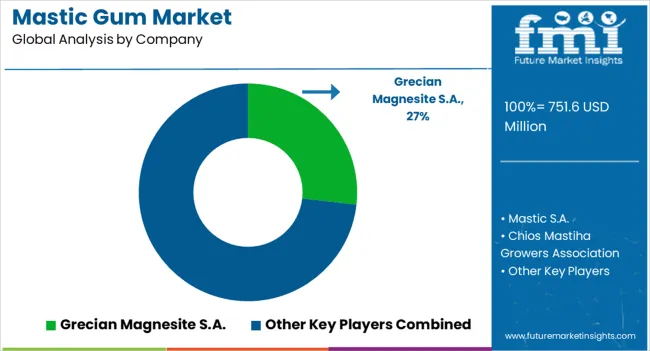
The competitive landscape of the mastic gum market is characterized by the presence of a few global players, as well as several regional and local players. The market is dominated by a few key players, such as Grecian Magnesite S.A., Mastic S.A., and Chios Mastiha Growers Association, who hold a significant share of the market. These companies have a strong presence in the market, as well as a wide range of product offerings. They also have a strong distribution network and a strong brand reputation.
However, there are also several regional and local players who hold a significant share of the market in their respective regions. These players focus on providing mastic gum products at a relatively lower price than the key players, and they also have a strong distribution network in their respective regions. Overall, the market is moderately consolidated, with the presence of both global and regional players.
| Attribute | Details |
|---|---|
| Forecast Period | 2025 to 2035 |
| Historical Data Available for | 2020 to 2025 |
| Market Analysis | USD Million for Value and Units for Volume |
| Key Regions Covered | North America; Latin America; Europe; Asia Pacific; MEA |
| Key Countries Covered | Philippines, India, Malaysia, Thailand, USA, Germany, China, Japan, Denmark, Canada, Mexico, Poland, UK, Turkey, France, Italy, Spain, South Korea, Russia, Australia, Brazil, Argentina, South Africa |
| Key Segments Covered | Type, End-user Industry, Region |
| Key Companies Profiled | Grecian Magnesite S.A.; Mastic S.A.; Chios Mastiha Growers Association; Merck KGaA; Lalilab Inc.; Sharawi Chewing Gum Factory; Mazaya’s Tobacco-Molasses |
| Report Coverage | DROT Analysis, Market Forecast, Company Share Analysis, Market Dynamics and Challenges, Competitive Landscape and Strategic Growth Initiatives |
| Customization & Pricing | Available upon Request |
The global mastic gum market is estimated to be valued at USD 751.6 million in 2025.
The market size for the mastic gum market is projected to reach USD 1,080.8 million by 2035.
The mastic gum market is expected to grow at a 3.7% CAGR between 2025 and 2035.
The key product types in mastic gum market are chewed pure mastic gum, xylitol mastic gum and others.
In terms of end-user industry, food service industry segment to command 47.6% share in the mastic gum market in 2025.






Our Research Products

The "Full Research Suite" delivers actionable market intel, deep dives on markets or technologies, so clients act faster, cut risk, and unlock growth.

The Leaderboard benchmarks and ranks top vendors, classifying them as Established Leaders, Leading Challengers, or Disruptors & Challengers.

Locates where complements amplify value and substitutes erode it, forecasting net impact by horizon

We deliver granular, decision-grade intel: market sizing, 5-year forecasts, pricing, adoption, usage, revenue, and operational KPIs—plus competitor tracking, regulation, and value chains—across 60 countries broadly.

Spot the shifts before they hit your P&L. We track inflection points, adoption curves, pricing moves, and ecosystem plays to show where demand is heading, why it is changing, and what to do next across high-growth markets and disruptive tech

Real-time reads of user behavior. We track shifting priorities, perceptions of today’s and next-gen services, and provider experience, then pace how fast tech moves from trial to adoption, blending buyer, consumer, and channel inputs with social signals (#WhySwitch, #UX).

Partner with our analyst team to build a custom report designed around your business priorities. From analysing market trends to assessing competitors or crafting bespoke datasets, we tailor insights to your needs.
Supplier Intelligence
Discovery & Profiling
Capacity & Footprint
Performance & Risk
Compliance & Governance
Commercial Readiness
Who Supplies Whom
Scorecards & Shortlists
Playbooks & Docs
Category Intelligence
Definition & Scope
Demand & Use Cases
Cost Drivers
Market Structure
Supply Chain Map
Trade & Policy
Operating Norms
Deliverables
Buyer Intelligence
Account Basics
Spend & Scope
Procurement Model
Vendor Requirements
Terms & Policies
Entry Strategy
Pain Points & Triggers
Outputs
Pricing Analysis
Benchmarks
Trends
Should-Cost
Indexation
Landed Cost
Commercial Terms
Deliverables
Brand Analysis
Positioning & Value Prop
Share & Presence
Customer Evidence
Go-to-Market
Digital & Reputation
Compliance & Trust
KPIs & Gaps
Outputs
Full Research Suite comprises of:
Market outlook & trends analysis
Interviews & case studies
Strategic recommendations
Vendor profiles & capabilities analysis
5-year forecasts
8 regions and 60+ country-level data splits
Market segment data splits
12 months of continuous data updates
DELIVERED AS:
PDF EXCEL ONLINE
Mastic Tapes Market from 2025 to 2035
Gum Rosin Market Size and Share Forecast Outlook 2025 to 2035
Gummed Tape Market Size and Share Forecast Outlook 2025 to 2035
Gummy Supplements Market Size and Share Forecast Outlook 2025 to 2035
Gum Arabic Market Analysis – Size, Share, and Forecast Outlook 2025 to 2035
Gummy Market Analysis by Product, Ingredient, End-Use, Distribution Channel, and Region - Forecast through 2025 to 2035
Gum Turpentine Oil Market Growth - Trends & Forecast 2025 to 2035
Gum Hydrocolloid Market Analysis by Product Type, Source, and Region through 2035
Key Companies & Market Share in the Gummed Tape Sector
Evaluating Gum Fiber Market Share & Provider Insights
Gum Content Tester Market
CBD Gummies Market Analysis - Size, Share and Forecast Outlook 2025 to 2035
Pre-Gummed Labels Market Growth - Demand & Forecast 2025 to 2035
Guar Gum Market Size and Share Forecast Outlook 2025 to 2035
Guar Gum for Construction Market Size and Share Forecast Outlook 2025 to 2035
Tara Gum Market Size and Share Forecast Outlook 2025 to 2035
Sleep Gummy Market Analysis by Primary Ingredient, Customer Orientation, Pack Size and Product Claim Through 2035
Paper Gummed Tape Market Growth - Demand & Forecast 2025 to 2035
CoQ10 Gummies Market Analysis by Source, Distribution Channels, and Key Regions Through 2035
Ester Gums Market Growth – Trends & Forecast 2025 to 2035

Thank you!
You will receive an email from our Business Development Manager. Please be sure to check your SPAM/JUNK folder too.
Chat With
MaRIA